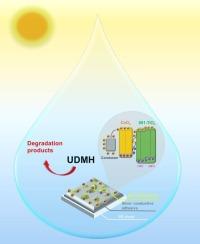A study on interfacial regulation and function mechanism of S-scheme 001-TiO2/CeO2 two-dimensional charge-separation Interface for photocatalytic degradation of unsymmetrical Dimethylhydrazine
IF 4.7
3区 化学
Q2 CHEMISTRY, PHYSICAL
Journal of Photochemistry and Photobiology A-chemistry
Pub Date : 2025-10-06
DOI:10.1016/j.jphotochem.2025.116818
引用次数: 0
Abstract
Unsymmetrical dimethylhydrazine (UDMH), as a high-energy liquid rocket fuel widely used for energy liquid rocket fuel, inevitably produces huge volumes of UDMH wastewater during use. As UDMH and its byproducts are both highly toxic, this poses a severe threat to ecological environment and human health, making it an urgent need to develop an efficient, environmentally friendly treatment for UDMH wastewater. Photocatalytic technology has emerged as a research hotspot in the field of water pollution control owing to its low cost and eco-friendliness. In this study, a (001) facet-dominated 001-TiO2/CeO2 S-scheme heterojunction was constructed via a solvothermal-photoassisted method, effectively achieving primary carrier separation. Under simulated solar irradiation, this structure achieved a 98.7 % degradation efficiency for 100 mg/L UDMH wastewater within 140 min, with degradation rate constants 3.8 times and 5.5 times higher than those of 001-TiO2 and P25, respectively. To address the challenge of recovering powdered photocatalysts, this study immobilized the nanopowders using a silver conductive adhesive, creating a two-dimensional conductor interface for electron transport and a nanoparticle structure for hole retention, thereby enabling secondary carrier separation. Under simulated solar irradiation, this immobilized structure achieved a 75.1 % degradation efficiency for 100 mg/L UDMH wastewater within 420 min. More importantly, it demonstrated excellent reusability and recyclability. This study provides a practical and feasible approach for the efficient degradation of UDMH wastewater.

S-scheme 001-TiO2/CeO2二维电荷分离界面光催化降解不对称二甲肼的界面调控及作用机理研究
不对称二甲肼(UDMH)作为一种广泛应用于能源液体火箭燃料的高能液体火箭燃料,在使用过程中不可避免地产生大量的UDMH废水。由于二甲基二甲肼及其副产品都具有剧毒,对生态环境和人类健康构成严重威胁,因此迫切需要开发一种高效、环保的二甲基二甲肼废水处理方法。光催化技术因其成本低、生态友好等优点,已成为水污染治理领域的研究热点。在本研究中,通过溶剂热光辅助方法构建了一个(001)面主导的001- tio2 /CeO2 S-scheme异质结,有效地实现了一次载流子分离。在模拟太阳照射下,该结构对100 mg/L UDMH废水的降解效率在140 min内达到98.7%,降解速率常数分别是001-TiO2和P25的3.8倍和5.5倍。为了解决回收粉状光催化剂的挑战,本研究使用银导电粘合剂固定纳米粉末,创建二维导体界面用于电子传输和纳米颗粒结构用于空穴保留,从而实现二次载流子分离。在模拟太阳照射下,该固定化结构在420 min内对100 mg/L UDMH废水的降解效率达到75.1%。更重要的是,它具有良好的可重复使用性和可回收性。本研究为UDMH废水的高效降解提供了一条切实可行的途径。
本文章由计算机程序翻译,如有差异,请以英文原文为准。
求助全文
约1分钟内获得全文
求助全文
来源期刊
CiteScore
7.90
自引率
7.00%
发文量
580
审稿时长
48 days
期刊介绍:
JPPA publishes the results of fundamental studies on all aspects of chemical phenomena induced by interactions between light and molecules/matter of all kinds.
All systems capable of being described at the molecular or integrated multimolecular level are appropriate for the journal. This includes all molecular chemical species as well as biomolecular, supramolecular, polymer and other macromolecular systems, as well as solid state photochemistry. In addition, the journal publishes studies of semiconductor and other photoactive organic and inorganic materials, photocatalysis (organic, inorganic, supramolecular and superconductor).
The scope includes condensed and gas phase photochemistry, as well as synchrotron radiation chemistry. A broad range of processes and techniques in photochemistry are covered such as light induced energy, electron and proton transfer; nonlinear photochemical behavior; mechanistic investigation of photochemical reactions and identification of the products of photochemical reactions; quantum yield determinations and measurements of rate constants for primary and secondary photochemical processes; steady-state and time-resolved emission, ultrafast spectroscopic methods, single molecule spectroscopy, time resolved X-ray diffraction, luminescence microscopy, and scattering spectroscopy applied to photochemistry. Papers in emerging and applied areas such as luminescent sensors, electroluminescence, solar energy conversion, atmospheric photochemistry, environmental remediation, and related photocatalytic chemistry are also welcome.

 求助内容:
求助内容: 应助结果提醒方式:
应助结果提醒方式:


